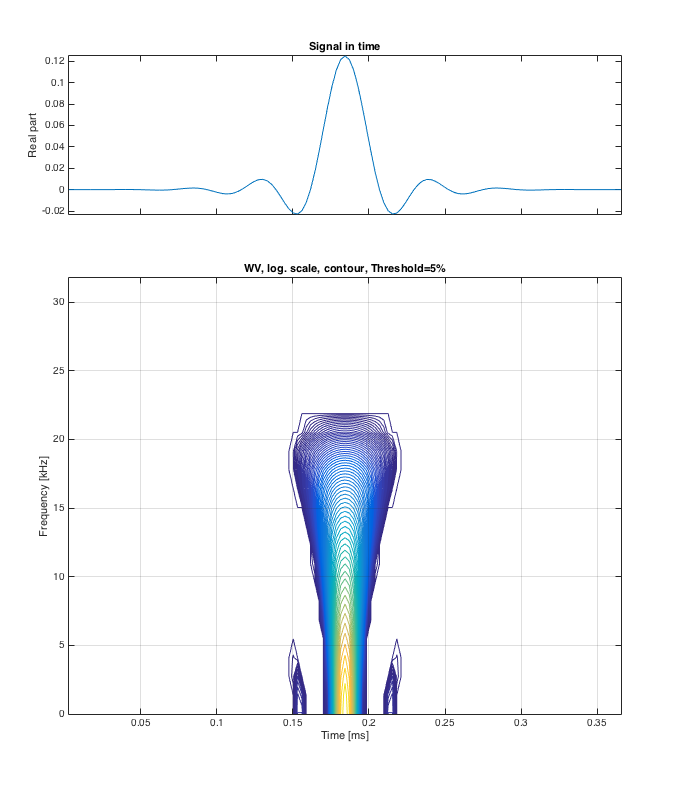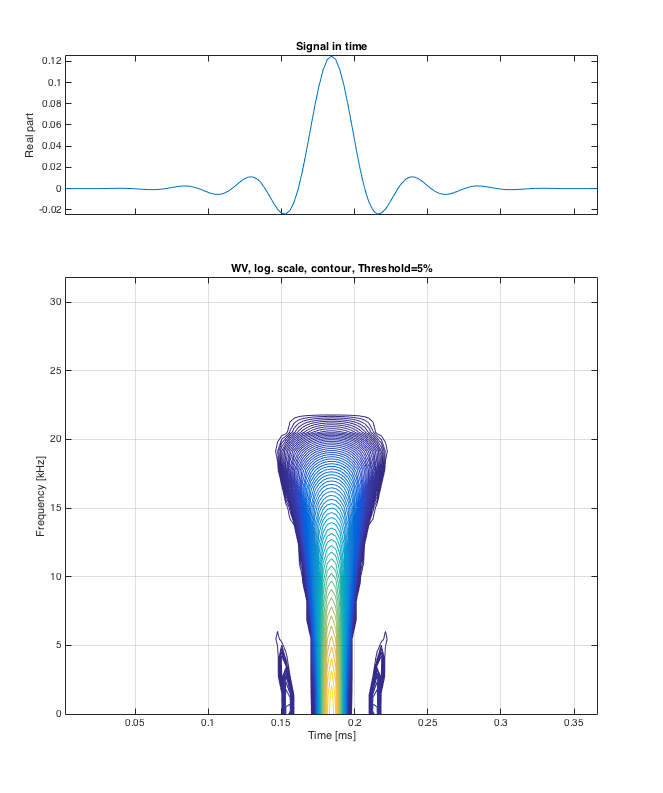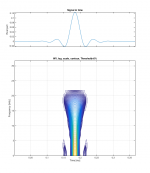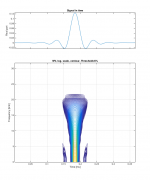Gotta keep that authentic FM radio feel to keep the record labels happy I suppose, making it no substitute to the real album. 🙂
My preference is to always support artists and small labels I like buy purchasing music I listen to through sites like bandcamp, or directly from label websites.
Don't give a rats **** about the garbage major labels foist on the public. I'll go on record as saying I have never knowingly listened to a single thing Lady GaGa has released. 😀
Apodization...
Came across a paper that looks like it may have been an uncredited inspiration for Craven's work on Apodization.
The introduction to Craven's "Antialias Filter and System Transient Response at High Sample Rates" (in AES Journal Vol 52, No. 3, 2004) he states:
"We introduce “apodization,” a term used in radio astronomy, as a means of limiting the time smear of a band-limiting filter, and show that a single apodizing filter can be used to control the time smear of a complete recording and reproducing chain."
The paper "Nonlinear Apodization for Sidelobe Control in SAR Imagery" was published in 1995 and discusses "apodization" of filters used to process radar imagery to reduce side lobes without sacrificing the main lobe resolution.
http://www.optics.rochester.edu/workgroups/fienup/PUBLICATIONS/IEEE-AES95_SVA.pdf
One of the methods they describe involves making two versions of an image one with a uniform window, and a second with a Hann window. The two versions are compared. If the values have opposite signs the value is set to 0, if the values have the same sign, the smallest absolute value is chosen. The idea seems to be that near the centre lobe the uniform window version will have the narrowest lobes so you end up with improved resolution at the main lobe and better suppression of the side lobes.
Anyway it sounds like it could be worthwhile avenue to explore...
And thanks for the feedback on the C128's. The 100 version has lower level of sidelobe suppression, and this seems to improve the perceived level of bass slightly. I'd done some comparisons with my Konnekt 8 on a recording I know was made using a more featured variant of the same basic DAC, and the DAM was very light on in the bottom end in comparison. The -100 was done as a test to see if adjusting sidelobe attenuation helped that aspect.
I'll have a play around with apodizing a Nyquist filter to see if it brings anything worthwhile to SQ.
cheers
Paul
Note: Spellcheck seems to dislike "sidelobe" so if you see "sideline" you'll need to mentally correct back!!
Came across a paper that looks like it may have been an uncredited inspiration for Craven's work on Apodization.
The introduction to Craven's "Antialias Filter and System Transient Response at High Sample Rates" (in AES Journal Vol 52, No. 3, 2004) he states:
"We introduce “apodization,” a term used in radio astronomy, as a means of limiting the time smear of a band-limiting filter, and show that a single apodizing filter can be used to control the time smear of a complete recording and reproducing chain."
The paper "Nonlinear Apodization for Sidelobe Control in SAR Imagery" was published in 1995 and discusses "apodization" of filters used to process radar imagery to reduce side lobes without sacrificing the main lobe resolution.
http://www.optics.rochester.edu/workgroups/fienup/PUBLICATIONS/IEEE-AES95_SVA.pdf
One of the methods they describe involves making two versions of an image one with a uniform window, and a second with a Hann window. The two versions are compared. If the values have opposite signs the value is set to 0, if the values have the same sign, the smallest absolute value is chosen. The idea seems to be that near the centre lobe the uniform window version will have the narrowest lobes so you end up with improved resolution at the main lobe and better suppression of the side lobes.
Anyway it sounds like it could be worthwhile avenue to explore...
And thanks for the feedback on the C128's. The 100 version has lower level of sidelobe suppression, and this seems to improve the perceived level of bass slightly. I'd done some comparisons with my Konnekt 8 on a recording I know was made using a more featured variant of the same basic DAC, and the DAM was very light on in the bottom end in comparison. The -100 was done as a test to see if adjusting sidelobe attenuation helped that aspect.
I'll have a play around with apodizing a Nyquist filter to see if it brings anything worthwhile to SQ.
cheers
Paul
Note: Spellcheck seems to dislike "sidelobe" so if you see "sideline" you'll need to mentally correct back!!
Last edited:
I think the dam dac is light on bass with all filters. What's the output impedance in relation to freq response?
I've been disturbed about bass from outset, thought filter would maybe fix it, but starting to think there is another issue at play.
I've been disturbed about bass from outset, thought filter would maybe fix it, but starting to think there is another issue at play.
I think the dam dac is light on bass with all filters. What's the output impedance in relation to freq response?
I've been disturbed about bass from outset, thought filter would maybe fix it, but starting to think there is another issue at play.
Think its a dynamics issue that's causing the light bass or lack of weight
Detail seems to be fine
But is worrying as I have done a few power mods that usually help dynamics
Have not tested many filters yet only the couple of nos
But is worrying as I have done a few power mods that usually help dynamics
Have not tested many filters yet only the couple of nos
Why is it worrying? It probably means that the power supply on the stock board is sufficiently good that your "improvements" make no difference.
The filters are not EQ. They are reconstruction filters that are essentially dead flat under 10kHz. The only difference that will effect bass quality is roll off between 13-20kHz which will make the bottom end sound slightly more forward.
Last edited:
Just snapped the TOSLINK RX off the proto-board... bugger.
Anyway as a bit of a reality check I've hooked up the DAM via SPDIF with a Stello U3 USB->SPDIF convertor in place of the Amanero I usually run.
I'm very surprised at the level of difference. Over SPDIF the DAM sounds more solid but less airy. The tonal balance is much closer to my Konnekt 8 and D1v3, in that it's not nearly as skewed to the tops as the DAM running via I2S.
I've tried switching back and forth a couple of times and there is a clear difference. Basically SPDIF is darker sounding, IS2 is more forward, detailed and thinner in the bottom end.
Not really what I expected to hear...
Anyway as a bit of a reality check I've hooked up the DAM via SPDIF with a Stello U3 USB->SPDIF convertor in place of the Amanero I usually run.
I'm very surprised at the level of difference. Over SPDIF the DAM sounds more solid but less airy. The tonal balance is much closer to my Konnekt 8 and D1v3, in that it's not nearly as skewed to the tops as the DAM running via I2S.
I've tried switching back and forth a couple of times and there is a clear difference. Basically SPDIF is darker sounding, IS2 is more forward, detailed and thinner in the bottom end.
Not really what I expected to hear...
For me spdif and i2s sound almost identical.
Spdif is with audio note spdif transformer
I2S via gustard u12 (usb from raspberry)
I was surprised there were so little difference in sound.
Well its been a while since I compared them
Spdif is with audio note spdif transformer
I2S via gustard u12 (usb from raspberry)
I was surprised there were so little difference in sound.
Well its been a while since I compared them
Last edited:
I don't know...
Audirvana+ is behaving like a piece of garbage when I shift inputs - plays tracks at wrong sample rate, crashes, etc, etc. It may well be that causing issues.
Audirvana+ is behaving like a piece of garbage when I shift inputs - plays tracks at wrong sample rate, crashes, etc, etc. It may well be that causing issues.
I found that in literature the "FIR1 upsample FIR2" ensamble goes as IFIR = Interpolated FIR filter. There are algorithms that compute you a matched pair of FIR1, FIR2. Mathlab has the ifir() command for that (but unfortunatelly not too much options).
In the example I have seen with the "advanced" option, e.g. the FIR2 has already some noticeable attenuation in passband, wich was corrected with FIR1 resulting in shorter filters with the same performance.
I thing it would be no big issue for Soren to support loading of matched pairs of FIR filters if that shows to be useful.
P.S. to Craven and Apodization. I think Apodization is just the learned name for the technique he applied. As the Greg-Latin names were more in fashion in the past it does not surprise, you find on google scholar articles with that from the 60-is.
You also do not quote the inventor of the knife every time you use it.
In the example I have seen with the "advanced" option, e.g. the FIR2 has already some noticeable attenuation in passband, wich was corrected with FIR1 resulting in shorter filters with the same performance.
I thing it would be no big issue for Soren to support loading of matched pairs of FIR filters if that shows to be useful.
P.S. to Craven and Apodization. I think Apodization is just the learned name for the technique he applied. As the Greg-Latin names were more in fashion in the past it does not surprise, you find on google scholar articles with that from the 60-is.
You also do not quote the inventor of the knife every time you use it.
Don't give a rats **** about the garbage major labels foist on the public. I'll go on record as saying I have never knowingly listened to a single thing Lady GaGa has released. 😀
Her recent work with Tony Bennett is both surprising and stunning. She really can sing.
Why is it worrying? It probably means that the power supply on the stock board is sufficiently good that your "improvements" make no difference.
The filters are not EQ. They are reconstruction filters that are essentially dead flat under 10kHz. The only difference that will effect bass quality is roll off between 13-20kHz which will make the bottom end sound slightly more forward.
not what i meant
if the optimum amount and quality of weight cant be gained with filters where can it be obtained
my power system has helped sq vastly
but its still a little short on weight
These, without the filter but with 38k on input, I think helped me in the weight department.
JG buffer - I2S over USB Audio
//
JG buffer - I2S over USB Audio
//
ive +/- 5v direct from lifepo4 cells into the opamps for the 4v referenceThese, without the filter but with 38k on input, I think helped me in the weight department.
JG buffer - I2S over USB Audio
//
doubt ill get much better than that
OK - haven't started to tweak the board yet. If ever...
//
That could be wise I already killed one board (silly mistake)
But would advocate a good DC supply and for the more adventurous something special for the 3.3v supply
The rest ain't so bad
Ac input was a car crash for me
not what i meant
if the optimum amount and quality of weight cant be gained with filters where can it be obtained
my power system has helped sq vastly
but its still a little short on weight
I'm aware the filters sound a little light on bass, but it's not something that I'm going to attempt to fix by adding 1-2dB of boost below 250Hz for example. The measured response at the outputs is actually dead flat in this range, so it's not actually a problem with the DAC or filters per se.
Ultimately the solution is going to come from understanding the reasons this is occurring rather than trying to compensate with add-ons. You'll just have to be a little bit patient.
I'm aware the filters sound a little light on bass, but it's not something that I'm going to attempt to fix by adding 1-2dB of boost below 250Hz for example. The measured response at the outputs is actually dead flat in this range, so it's not actually a problem with the DAC or filters per se.
Ultimately the solution is going to come from understanding the reasons this is occurring rather than trying to compensate with add-ons. You'll just have to be a little bit patient.
Good.
//
I've been trying to find a way to visualise the impulse in the time-frequency domain as I'm convinced this is more informative than time domain or frequency domains. There is a paper on the dirac site which indicates that only time-frequency domain adequately represents perceived frequency response.
This is a Wigner-Ville contour plot done with the time-frequency toolbox for Octave/Matlab from TFTB -- Time-Frequency toolbox

This a plot of the C128_100 impulse. It seems to show similar information the STFT plots, but less cluttered. There is a mesh plot that can be done which show the impulse in 3 dimensions but it doesn't translate well to a static image.
I've done a bit of chasing on the bass issue, and still not sure exactly what is going on. I have a sneaking suspicion that going for minimal ring is part of the problem. C128_180 - which really crunches the side lobes - sounds pretty awful, to the point I won't bother posting. Going the opposite direction and using a kaiser window at beta=8 (which gives around 80dB attenuation to the stop band ala John Swenson Bottle Head) sounds pretty good, although it might be heading down the path of being overly forward. It is punchy and detailed, I won't commit to it being better in the bottom end. Sounds pretty decent on Pete Namlook & Material Object's "elektronik"...

This is a Wigner-Ville contour plot done with the time-frequency toolbox for Octave/Matlab from TFTB -- Time-Frequency toolbox
This a plot of the C128_100 impulse. It seems to show similar information the STFT plots, but less cluttered. There is a mesh plot that can be done which show the impulse in 3 dimensions but it doesn't translate well to a static image.
I've done a bit of chasing on the bass issue, and still not sure exactly what is going on. I have a sneaking suspicion that going for minimal ring is part of the problem. C128_180 - which really crunches the side lobes - sounds pretty awful, to the point I won't bother posting. Going the opposite direction and using a kaiser window at beta=8 (which gives around 80dB attenuation to the stop band ala John Swenson Bottle Head) sounds pretty good, although it might be heading down the path of being overly forward. It is punchy and detailed, I won't commit to it being better in the bottom end. Sounds pretty decent on Pete Namlook & Material Object's "elektronik"...
Attachments
I've been trying to find a way to visualise the impulse in the time-frequency domain as I'm convinced this is more informative than time domain or frequency domains. There is a paper on the dirac site which indicates that only time-frequency domain adequately represents perceived frequency response.
This is a Wigner-Ville contour plot done with the time-frequency toolbox for Octave/Matlab from TFTB -- Time-Frequency toolbox

This a plot of the C128_100 impulse. It seems to show similar information the STFT plots, but less cluttered. There is a mesh plot that can be done which show the impulse in 3 dimensions but it doesn't translate well to a static image.
I've done a bit of chasing on the bass issue, and still not sure exactly what is going on. I have a sneaking suspicion that going for minimal ring is part of the problem. C128_180 - which really crunches the side lobes - sounds pretty awful, to the point I won't bother posting. Going the opposite direction and using a kaiser window at beta=8 (which gives around 80dB attenuation to the stop band ala John Swenson Bottle Head) sounds pretty good, although it might be heading down the path of being overly forward. It is punchy and detailed, I won't commit to it being better in the bottom end. Sounds pretty decent on Pete Namlook & Material Object's "elektronik"...

Yeah but like you said, the filters don't do EQ. Something else is causing weak bass, can someone do an output impedance/ frequency plot on unbuffered output.
Have at least 5 dacs laying around. The dam has not weak bass in my setup. Initially I felt so. After playing some hundred hours this is not a problem. The bass is deep, powerfull and articulate.
With the latest "NOS" filters there is even more. ? Hard to describe.
Using unbuffered outputs.
AC 7.5V (50va trannie) direct into the dam.
Amplifer used for the time being has approx 10k input impedance
With the latest "NOS" filters there is even more. ? Hard to describe.
Using unbuffered outputs.
AC 7.5V (50va trannie) direct into the dam.
Amplifer used for the time being has approx 10k input impedance
Last edited:
- Home
- Source & Line
- Digital Line Level
- Filter brewing for the Soekris R2R

